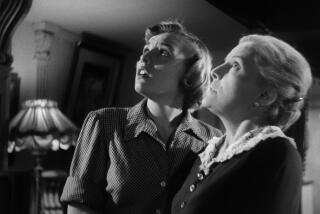How a Lost Western Was Won Back After 40 Years
For the first time in four decades, the Silent Movie Theatre will be screening the landmark 1923 epic “The Covered Wagon” on Wednesday as part of a weeklong celebration of vintage westerns.
Produced by Jesse L. Lasky and directed by James Cruze, “The Covered Wagon” was the most lavish western of its day. The granddaddy of wagon train adventures, the sagebrush saga was a staple at the revival movie theater throughout the ‘40s until the mid-1950s. Then Paramount, the studio that released the film, decided to take the Silent Movie Theatre’s original owner, John Hampton, to court for copyright violation.
Hampton, explains film historian and preservationist David Shepard, thought he had done nothing illegal in showing “The Covered Wagon,” as well as numerous other Paramount features.
“He had bought this film with no strings attached from a company that had a legitimate right to sell it,” Shepard says. “He wasn’t going to back down on a movie he felt he had the right to use.” Hampton spent some five years in federal courts trying to retain ownership of the film.
Hampton bought a 16-millimeter print of “The Covered Wagon” in 1932 from Eastman Kodak and even kept the receipt.
After the creation of 16-millimeter film in the 1920s, Shepard says, “Kodak knew that people would not go out and buy the [movie] equipment if all they could show on it was whatever small amounts of film they shot of their vacation. So they went to the Hollywood studios and made deals with virtually every one of them to select films from their library.”
Eastman Kodak then made 16-millimeter prints of these films, which one could either rent or buy. “They called this the Kodascope Library,” Shepard says. “They had Kodascope Libraries all over the world. ‘The Covered Wagon’ was one of the most important films they got because it was a huge blockbuster movie in its day.”
By the time Hampton opened the Silent Movie Theatre in 1942, Shepard says, “he had amassed quite a large collection of films. ‘The Covered Wagon’ was one of the ones he showed and did so without anybody saying a peep for about 10 years.”
That was until a revival theater rival, Raymond Rohauer, tipped Paramount.
“Rohauer was not very scrupulous when it came to matters of observing copyright,” Shepard says.
“He stepped on Paramount’s toes by running a French movie they owned the rights to. When they came after him, he essentially made a bargain, which was if they would sort of slap his hands, he would put them on to a whole bunch of people who were violating their copyright. He had to find someone, and he pointed to his rival down the street.”
So Paramount sued Hampton “for willful infringement of copyright, which is a federal crime,” Shepard says. Paramount’s attorneys found a legal technicality under which they won their case.
“There is a principle in the copyright law called the principle of new estate,” Shepard says. “At the end of a 28-year term of ownership, the copyright could be renewed or the widows and orphans of the copyright [holder] could renew.
“However, there was a so-called ‘dead man’s clause’ that said if you died during the original term, the terms of the copyright became null and void and the widows and orphans got the rights back and one would have to renegotiate again.”
During the Depression, Paramount went into bankruptcy and reorganized. “The lawyers persuaded the judge that that consisted of the death of the old company, so that the newly organized company regained all of those rights.”
Hampton, who died in 1979, appealed the case and lost but, adds Shepard, “the judge felt the equities of the case were with Hampton and not with Paramount, so his fine was $100.”
Charlie Lustman, the new owner of the Silent Movie Theatre, was going through Hampton’s papers when he discovered correspondence dealing with the lawsuit. “I was just, like, ‘Whoa, cool,’ ” he says. “Hampton was quite a guy. He really stood for what he believed in.”
So Lustman decided to make “The Covered Wagon” the showcase of his western festival. After some detective work, he was able to get a complete 35-millimeter print of the movie from Paramount. “It’s a beautiful print,” he gushes. The movie will be screened with live organ accompaniment.
Introducing the screening will be veteran western movie producer A.C. Lyles. “The Covered Wagon,” Lyles says, “was responsible for the making of the word epic.” In 1966, Lyles was even considering remaking it with veteran director John Ford at the helm.
“I invited him to Paramount to see the picture,” Lyles recalls. “He loved it and I loved it, but we thought it was going to be a very expensive picture to make and we decided we couldn’t make it better than it was. We thought it would be a mistake to try.”
* “The Covered Wagon” screens Wednesday at 8 p.m. at the Silent Movie Theatre, 611 N. Fairfax Ave., Los Angeles. Admission is $8 for adults and $6 for children, seniors and students. Information: (323) 655-2520.
(BEGIN TEXT OF INFOBOX / INFOGRAPHIC)
Schedule for Wild Western Week Today: “Way Out West” with Laurel and Hardy.
Wednesday: “The Covered Wagon.”
Thursday: “Sky High” with Tom Mix.
Friday: “Hell’s Hinges” with William S. Hart.
Saturday and Sunday (matinee): “Go West” with Buster Keaton.
Sunday (evening): “Melody Ranch” with Gene Autry.
May 29: “Stagecoach” with John Wayne.
More to Read
Only good movies
Get the Indie Focus newsletter, Mark Olsen's weekly guide to the world of cinema.
You may occasionally receive promotional content from the Los Angeles Times.











